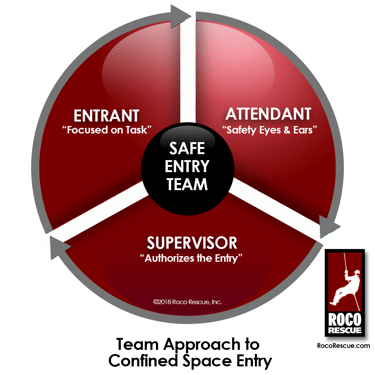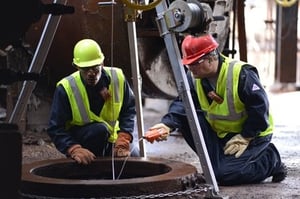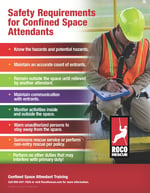So You’re the Confined Space Hole Watch…Now What?

First of all, don’t let the jargon “hole watch” fool you. The attendant’s role is key to the safety of the entry operation, and especially for the entrants inside the space. Lives are literally on the line – including the attendant’s if a bad decision is made to enter the space.
As you can see from the graphic, the hole watch (attendant) is the “eyes and ears of safety” and a crucial part of the Safe Entry Team. This position is critical to watching out for the entrants and recognizing the need for calling emergency services – and, of course, the quicker the better. One more reason the position of hole watch cannot be taken lightly.
It is also the responsibility of the employer or entry supervisor to make sure that the attendant receives adequate training prior to the entry. The attendant needs to be capable of monitoring the entrants and reacting properly in an emergency. This may include the operation of retrieval systems should evacuation become necessary.

If there are any changes to the entry operations, the attendant may require additional training depending on the hazards. Re-training is also required if there are any deviations from the permit space procedures – or if the employer feels the attendant is inadequately prepared.
Hole Watch is critical for entrant safety and knowing when to call emergency services–and, of course, the quicker the better.
As a reminder, employers or entry supervisors are required to…
- Provide the support that attendants need to fulfill their role.
- Provide informational resources concerning the hazards or potential hazards.
- Provide the necessary equipment and training as required.
- Determine if the attendant will be authorized to perform non-entry rescue (retrieval) and clearly communicate this to the attendant.
“Do’s and Don’ts” for the Confined Space Hole Watch
Diligence is critical for the hole watch or attendant. It’s a very important position. Pay attention and know your job! Here are a few “Do’s” and “Don’ts” to remember if you’re assigned the task of hole watch.
"Do's" for the Confined Space Attendant:
- Remain alert – lives are on the line.
- Take the initiative to learn everything you need to know as well as how to operate any equipment as required.
- Review the permit and understand the prohibited conditions.
- Know the hazards (or potential hazards) of the entry.
- Seek resources for more information (SDS, LOTO schedules, baseline assessments, etc.)
- Learn the mode of entry.
- Know the signs, symptoms and behavioral effects of exposure.
- Know the consequences of exposure.
- Keep track of entrants – know who is inside the space at all times. Use a tracking system (such as a roster) when there are multiple entrants. Do not rely on memory alone!
- Inform entry supervisor and entrants if unauthorized persons have entered the space.
- Use appropriate PPE for the area and ensure that basic needs are met (water, shade, etc.)
- Learn the proper operation of any required equipment including air monitoring, communications, non-entry rescue, etc.
- Conduct and log periodic air monitoring, as required. Note: Continuous air monitoring may be required based on Construction 1926 Subpart AA.
- Make sure that you have a reliable means to communicate with the entrants – and test it!
- Perform non-entry rescue (retrieval) as needed and if authorized to do so.
- Inspect retrieval equipment pre-entry and practice using it – don’t wait until there is an emergency to try and figure it out.
- Know how to contact rescue services (in advance) should the need arise.
- Summon the rescue service as soon as you determine that entrants may need assistance.
“Don’ts” for the Confined Space Attendant:
- Don’t accept the assignment as Hole Watch until you have been briefed on all planned activities both inside and outside the space.
- Don’t take your responsibilities lightly.
- Don’t leave the area outside the space unless relieved by another attendant.
- Don’t perform any duties that would distract or interfere with attendant duties.
- Don’t allow unauthorized persons to approach or enter the permit space – inform the entry supervisor as needed.
- Don’t wait until a suspected prohibited condition becomes obvious or worsens prior to ordering the entrants to evacuate the space. It’s better to err on the safe side vs. not evacuating the entrants soon enough!
- Don’t forget to keep a watch for hazards outside the space – such as unexpected airflows; heavy lifts in the area; and use of chemicals (or spills).
- Don’t enter the space to investigate, and don’t attempt an entry rescue unless you are authorized, trained and equipped to do so. Even then, you must first be relieved by another qualified attendant.
- Don’t allow the entry supervisor to close out a permit until 100% of entrants are accounted for and out of the space!
Hole Watch: A Crucial Connection
Once again, we can’t overemphasize the importance of the attendant or hole watch. Don’t take this position lightly. These individuals are the first line of protection for those inside the space. When selecting an attendant, make sure they are capable of handling the responsibilities of the job. They should be trained and prepared to act in an emergency. The timeliness of their response is crucial to the safety of the entrants. Failure to properly perform these duties has led to multiple fatalities – both for the entrants and the attendants themselves.

Additional Resources
- Attendant Safety Requirements Poster (pictured here)
- Confined Space Entry Checklist
- Common Causes of Confined Space Fatalities
- Limitations of Atmospheric Monitors




